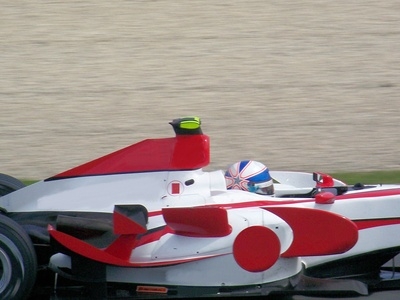
All modern gasoline-powered cars have throttle bodies. A throttle body controls airflow into the engine, a crucial factor for controlling the engine's air/fuel ratio. Throttle bodies come in several shapes, sizes and configurations and can perform several tasks outside of their normal air-metering duties.
A throttle body is essentially a large air valve that sits between the intake manifold and air intake pipe. Generally speaking, an engine has one throttle body, which bolts to the intake manifold's plenum (the large air cavity in the center).
Throttle bodies usually use butterfly valves. These valves consist of a casing with a large hole in the center, which is filled with a steel plate called a butterfly, or throttle plate. The throttle shaft is a rod that passes through the housing and is connected to the throttle cable on the outside and the throttle plate on the inside. When the throttle shaft turns, it rotates the throttle plate, allowing air to go around it and into the engine.
Barrel valves and slide valves are two other configurations sometimes found on throttle bodies, usually in racing applications. A barrel valve is a cylinder with a large channel drilled through its diameter. This type of valve sits inside of a cylindrical hole; rotating the barrel in its hole allows more air to pass through the channel. Slide valves (which are comprised of a single throttle plate sliding outward from the throttle body case) are even less common in automotive applications, but they're quite common on motorcycles.
Barrel valves and slide valves allow for more airflow than butterfly valves, but they don't control air as well. Even when completely open, a butterfly valve's throttle shaft and plate block a certain amount of the air passing through. Additionally, the butterfly valve's throttle plate causes turbulence in the airstream, which can be a bad thing when they're mounted very close to the cylinder head or fuel injector. The turbulence coming off of the throttle plate whips around behind it like a mini tornado, leaving a dead spot of stagnant air just behind the throttle plate. If this dead spot happens to coincide with the fuel injector location, then its fuel mist won't mix with the airstream, leading to an uneven fuel burn in the combustion chamber and poor performance.
However, this turbulence also helps to make butterfly valves more precise than the other types of valves. It's for this reason that barrel and slide valves are used almost exclusively on powerful, high-RPM engines; racecar drivers are usually either completely on or completely off the throttle, so the on/off nature of these types of valves doesn't negatively impact performance.
A throttle body also contains a secondary air channel known as the idle air control (IAC) circuit. The IAC contains a valve that allows the computer to precisely meter air at idle, which can be important under extremely hot or cold conditions. Additionally, the throttle body may contain a servo to open or control the throttle. Such servos work in concert with the computer's traction control (TC) system. If the computer detects wheelspin or power sliding, it will close the throttle plate somewhat to counteract this.